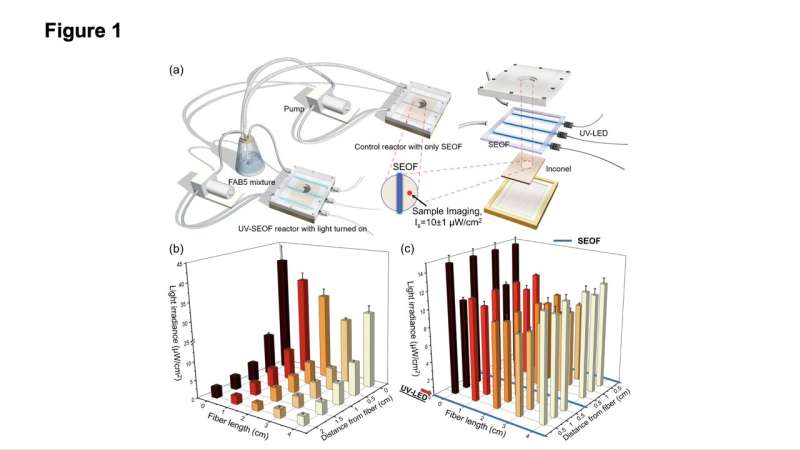This article has been reviewed according to Science X's editorial process and policies. Editors have highlighted the following attributes while ensuring the content's credibility:
fact-checked
peer-reviewed publication
trusted source
proofread
Shedding light on the dark problem of biofilms

Bacterial biofilms are clusters of microorganisms that form on wetted surfaces virtually everywhere. They harbor pathogens that compromise water quality, and they can disrupt the operation of many different engineered systems through the corrosion, fouling and clogging of tanks, pipes and valves.
In some settings, they could even be deadly. Space suits that enable crew operations outside of the International Space Station use recirculating water to regulate body temperatures in the orbital extremes of full sun (250 F) and full shade (-250 F). But biofilms blooming in those water lines have nearly compromised astronaut safety during spacewalks.
Ultraviolet, or UV, light offers an effective, chemical-free means of controlling this problem by damaging the DNA and enzyme repair systems of microbes—which leads to their demise. But the UV lamps commonly used for disinfecting water bring the risk of hazardous material leaks because they are mercury-based. Additionally, their designs are not practical for narrow-diameter tubing and other tight spaces where biofilms are likely to grow.
Seeking a practical solution, Arizona State University researchers collaborated with the start-up company H2Optic Insights to develop a novel method of using UV light, specifically shorter-wavelength UV-C, to inhibit biofilm growth in almost any space. The results of their work are published in the July issue of the journal Nature Water.
"Ultraviolet light has been extensively studied for its ability to deactivate bacteria and microorganisms in water," said Paul Westerhoff, the corresponding author of the paper and a professor of civil and environmental engineering in ASU's Ira A. Fulton Schools of Engineering. "But there is limited research on its effectiveness against bacteria in established biofilms, and a key challenge in biofilm research using UV-C light is delivering light effectively to surfaces in pressurized water systems."
Westerhoff and his team overcame this challenge by using LEDs connected to thin, side-emitting optical fibers, or SEOFs, placed directly on surfaces where biofilms can develop. The team successfully inhibited biofilm growth by delivering UV-C light through SEOFs at wavelengths of 265 or 275 nanometers and at low irradiance levels, just above a threshold of 9 µW/cm2.
The study also considered the impact of different UV wavelengths on biofilm inhibition, revealing that UV-A and UV-B had negligible effects at low irradiance levels where UV-C was effective. Westerhoff and his team further demonstrated that intermittent cycling of UV-C—with 10 minutes of irradiation followed by 50 minutes of dark time—achieved results comparable to continuous light exposure. That meant reducing energy use by more than 80%.
"From a design perspective, SEOFs offer a flexible solution for effectively illuminating extensive surface areas within narrow pipes or irregularly shaped surfaces," said Westerhoff, who also is deputy director of the National Science Foundation Nanosystems Engineering Research Center on Nanotechnology-Enabled Water Treatment (NEWT). "This can be achieved using either a single SEOF or multiple SEOFs integrated into mesh designs."
He said SEOFs also have the potential to revolutionize the design of apparatus for biofilm control since they can deliver UV at any wavelengths to surfaces where biofilms can develop and without the need to account for complications like light absorption or scattering through water, which would be a concern when using a point source LED to illuminate a surface.
"Using UV-C LEDs with SEOFs shows real promise in combating biofilms in water systems, particularly in enclosed and flowing water systems where traditional light delivery methods are limited," said Westerhoff. "So, these findings contribute to improving the safety, performance and energy efficiency of water treatment systems, including in challenging environments like the International Space Station."
Westerhoff said further research is required to explore how biofilms at various stages of development respond to UV light of different wavelengths. There also is a need to optimize the UV-SEOF method for different applications, such as biomedical devices and energy systems.
Other authors of the Nature Water paper are Zhe Zhao, Nora Shapiro, François Perreault and Bruce Rittmann—all from ASU—as well as Hojung Rho from the Korea Institute of Civil Engineering and Building Technology and Li Ling from the Advanced Interdisciplinary Institute of Environment and Ecology at Beijing Normal University.
More information: Zhe Zhao et al, Biofilm inhibition on surfaces by ultraviolet light side-emitted from optical fibres, Nature Water (2023). DOI: 10.1038/s44221-023-00111-7
Journal information: Nature Water
Provided by Arizona State University





















